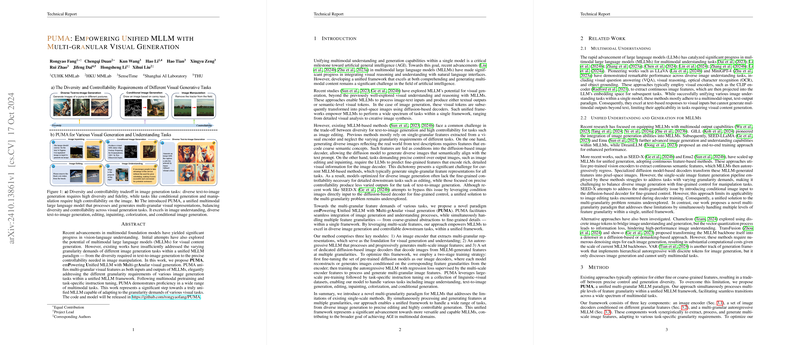Overview of PUMA: Empowering Unified MLLM with Multi-Granular Visual Generation
The paper "PUMA: Empowering Unified MLLM with Multi-Granular Visual Generation" presents a novel approach in the domain of multimodal LLMs (MLLMs). The proposed method, PUMA, introduces a unified framework capable of addressing the varying granularity requirements across different visual generation tasks. This work aims to integrate various granularity features into MLLMs, enhancing both the diversity of text-to-image generation and the controllability needed for precise tasks like image editing.
Introduction
MLLMs have shown significant potential in integrating visual reasoning and understanding within natural language frameworks. Nonetheless, their effectiveness in visual content generation, especially across varied granularity tasks, remains a challenge. Existing models often face trade-offs between content diversity and image controllability due to their reliance on single-granularity feature representations. PUMA addresses these limitations by providing a multi-granular approach that balances these demands within a unified MLLM framework.
Methodology
PUMA's architecture comprises three key components:
- Image Encoder: This module extracts multi-scale features from input images. Using a CLIP-based semantic image encoder, it processes images into high-resolution feature sets, progressively pooling to derive multiple granularity levels.
- Multi-Granular Visual Decoders: Utilizing a series of diffusion-based models, these decoders transform multi-granular image features into pixel-space images. This design accommodates various task demands, from high diversity generation to fine-grained reconstruction.
- Autoregressive MLLM: This module processes and generates text and image features progressively. It captures dependencies across scales by structuring inputs as multi-granular sequences. The training involves a combination of cross-entropy for text and regression loss for image features.
The training strategy includes multimodal pretraining with large datasets followed by task-specific instruction tuning to enhance PUMA's performance across diverse tasks.
Experimental Results
PUMA demonstrates enhanced capabilities in several key areas:
- Fine-Grained Image Reconstruction: The model's fine-grained scales achieved superior reconstruction quality compared to state-of-the-art models while maintaining efficiency.
- Semantics-Guided Diversity: For text-to-image generation, PUMA achieved a balance between semantic fidelity and output diversity, outperforming competitors in preserving prompt relevance and maintaining diversity.
- Image Editing and Conditional Generation: PUMA showed strong performance in image editing tasks, effectively preserving critical details and aligning outputs with target captions. It also demonstrated versatility in tasks like canny-to-image transformation and colorization.
- Image Understanding: The paper reports competitive results across several MLLM benchmarks, validating the effectiveness of PUMA's multi-granular approach for image comprehension tasks.
Implications and Future Directions
The PUMA framework represents an advancement in creating versatile and capable MLLMs, capable of handling various visual and linguistic tasks under a single unified model. The multi-granularity paradigm paves the way for future developments in adaptable AI systems, potentially contributing to the broader aim of achieving artificial general intelligence in multimodal domains.
Future research can explore expanding the granularity levels further or integrating additional modalities to enhance the model’s adaptability. Additionally, leveraging PUMA in real-world applications could validate its effectiveness in diverse settings, offering insights into practical and theoretical MLLM advancements.
In summary, PUMA offers a significant contribution to the field by addressing the trade-offs between diversity and precision in visual generation tasks, enhancing the potential for more sophisticated and adaptable AI systems.
